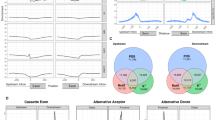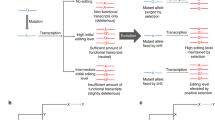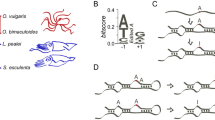Abstract
Genomic recoding by A→I RNA editing plays an important role in diversifying the proteins involved in electrical excitability. Here, we describe editing of an intronless potassium channel gene. A small region of human KV1.1 mRNA sequence directs efficient modification of one adenosine by human adenosine deaminase acting on RNA 2 (hADAR2). Mutational analysis shows that this region adopts a hairpin structure. Electrophysiological characterization reveals that the editing event (I/V) profoundly affects channel inactivation conferred by accessory β subunits. Drosophila melanogaster Shaker channels, mimicking this editing event through mutation, exhibit a similar effect. In addition, we demonstrate that mRNAs for the paralogous D. melanogaster Shab potassium channel are edited at the same position by fly ADAR—a clear example of convergent evolution driven by adenosine deamination. These results suggest an ancient and key regulatory role for this residue in KV channels.
This is a preview of subscription content, access via your institution
Access options
Subscribe to this journal
Receive 12 print issues and online access
$189.00 per year
only $15.75 per issue
Buy this article
- Purchase on Springer Link
- Instant access to full article PDF
Prices may be subject to local taxes which are calculated during checkout





Similar content being viewed by others
References
Hille, B. Ion Channels of Excitable Membranes (Sinauer Associates, Sunderland, Massachusetts, USA, 2001).
Patton, D., Silva, T. & Bezanilla, F. RNA editing generates a diverse array of transcripts encoding squid KV2 K+ channels with altered functional properties. Neuron 19, 711–722 (1997).
Rosenthal, J. & Bezanilla, F. Extensive editing of mRNAs for the squid delayed rectifier K+ channel regulates subunit tetramerization. Neuron 30, 743–757 (2002)
Hoopengardner, B., Bhalla, T., Staber, C. & Reenan, R. Nervous system targets of RNA editing identified by comparative genomics. Science 301, 832–836 (2003).
Seeburg, P. & Hartner, J. Regulation of ion channel/neurotransmitter receptor function by RNA editing. Curr. Opin. Neurobiol. 13, 279–283 (2003).
Higuchi, M. et al. RNA editing of AMPA receptor subunit GluR-B: a base-paired intron-exon structure determines position and efficiency. Cell 75, 1361–1370 (1993).
Herb, A., Higuchi, M., Sprengel, R. & Seeburg, P. Q/R site editing in kainate receptor GluR5 and GluR6 pre-mRNAs requires distant intronic sequences. Proc. Natl. Acad. Sci. USA 93, 1875–1880 (1996).
Burns, C. et al. Regulation of serotonin-2C receptor G-protein coupling by RNA editing. Nature 387, 303–308 (1997).
Aruscavage, P. & Bass, B. A phylogenetic analysis reveals an unusual sequence conservation within introns involved in RNA editing. RNA 6, 257–269 (2000).
Dawson, T., Sansam, C. & Emeson, R. Structure and sequence determinants required for the RNA editing of ADAR2 substrates. J. Biol. Chem. 279, 4941–4951 (2004).
Zuker, M. Mfold web server for nucleic acid folding and hybridization prediction. Nucleic Acids Res. 31, 3406–3415 (2003).
Liu, Y., Holmgren, M., Jurman, M. & Yellen, G. Gated access to the pore of a voltage-dependent K+ channel. Neuron 19, 175–184 (1997).
Doyle, D. et al. The structure of the potassium channel: molecular basis of K+ conduction and selectivity. Science 280, 69–77 (1998).
Zhou, M., Morais-Cabral, J., Mann, S. & MacKinnon, R. Potassium channel receptor site for the inactivation gate and quaternary amine inhibitors. Nature 411, 657–661 (2001).
Rettig, J. et al. Inactivation properties of voltage-gated K+ channels altered by presence of β-subunit. Nature 369, 289–294 (1994).
Singer-Lahat, D., Dascal, N. & Lotan, I. Modal behavior of the Kv1.1 channel conferred by the Kvβ1.1 subunit and its regulation by dephosphorylation of Kv1.1. Pflugers Arch. 439, 18–26 (1999).
Jing, J. et al. Fast inactivation of a brain K+ channel composed of Kv1.1 and Kvβ1.1 subunits modulated by G protein β γ subunits. EMBO J. 18, 1245–1256 (1999).
Levin, G. et al. Phosphorylation of a K+ channel α subunit modulates the inactivation conferred by a β subunit. Involvement of cytoskeleton. J. Biol. Chem. 271, 29321–29328 (1996).
Ivanina, T. et al. Phosphorylation by protein kinase A of RCK1 K+ channels expressed in Xenopus oocytes. Biochemistry 33, 8786–8792 (1994).
Wang, Z., Kiehn, J., Yang, Q., Brown, A.M. & Wible, B.A. Comparison of binding and block produced by alternatively spliced Kvβ1 subunits. J. Biol. Chem. 271, 28311–28317 (1996).
Hoshi, T., Zagotta, W. & Aldrich, R. Biophysical and molecular mechanisms of Shaker potassium channel inactivation. Science 250, 533–538 (1990).
Murrell-Lagnado, R. & Aldrich, R. Interactions of amino terminal domains of Shaker K channels with a pore blocking site studied with synthetic peptides. J. Gen. Physiol. 102, 949–975 (1993).
Murrell-Lagnado, R.D & Aldrich, R.W. Energetics of Shaker K+ channels block by inactivation peptides. J. Gen. Physiol. 102, 977–1003 (1993).
Palladino, M.J., Keegan, L.P., O'Connell, M.A. & Reenan, R.A. A-to-I pre-mRNA editing in Drosophila is primarily involved in adult nervous system function and integrity. Cell 102, 437–449 (2000).
Polson, A.G. & Bass, B.L. Preferential selection of adenosines for modification by double-stranded RNA adenosine deaminase. EMBO J. 13, 5701–5711 (1994).
Liu, Y., George, C., Patterson, J. & Samuel, C. Functionally distinct double-stranded RNA-binding domains associated with alternative splice site variants of the interferon-inducible double-stranded RNA-specific adenosine deaminase. J. Biol. Chem. 272, 4419–4428 (1997).
Yang, J. et al. Widespread inosine-containing mRNA in lymphocytes regulated by ADAR1 in response to inflammation. Immunology 109, 15–23 (2003).
Demo, S.D. & Yellen, G. The inactivation gate of the Shaker K+ channel behaves like an open-channel blocker. Neuron 7, 743–753 (1991).
Gomez-Lagunas, F. & Armstrong, C.M. The relation between ion permeation and recovery from inactivation of ShakerB K+ channels. Biophys. J. 67, 1806–1815 (1994).
Baukrowitz, T. & Yellen, G. Modulation of K+ current by frequency and external [K+]: a tale of two inactivation mechanisms. Neuron 15, 951–960 (1995).
Connor, J.A. & Steven, C.F. Prediction of repetitive firing behaviour from voltage clamp data on an isolated neurone soma. J Physiol. 213, 31–53 (1971).
Aldrich R.W., Getting P.A. & Thompson, S.H. Mechanism of frequency-dependent broadening of molluscan neurone soma spikes. J Physiol. 291, 531–544 (1979).
Debanne, D., Guerineau, N.C., Gahwiler, B.H. & Thompson, S.M. Action-potential propagation gated by an axonal I(A)-like K+ conductance in hippocampus. Nature 389, 286–289 (1997).
Hoffman, D.A., Magee, J.C., Colbert, C.M. & Johnston, D. K+ channel regulation of signal propagation in dendrites of hippocampal pyramidal neurons. Nature 387, 869–875 (1997).
Giese, K.P. et al. Reduced K+ channel inactivation, spike broadening, and after-hyperpolarization in Kvβ1.1-deficient mice with impaired learning. Learn. Mem. 5, 257–273 (1998).
Herson, P.S. et al. A mouse model of episodic ataxia type-1. Nat. Neurosci. 6, 378–383 (2003).
Kawahara, Y. et al. Glutamate receptors: RNA editing and death of motor neurons. Nature 427, 801 (2004).
Higuchi, M. et al. Point mutation in an AMPA receptor gene rescues lethality in mice deficient in the RNA-editing enzyme ADAR2. Nature 406, 78–81 (2000).
Kamb, A., Tseng-Crank, J. & Tanouye, M.A. Multiple products of the Drosophila Shaker gene may contribute to potassium channel diversity. Neuron 1, 421–430 (1988).
Jurman, M.E., Boland, L.M., Liu, Y. & Yellen, G. Visual identification of individual transfected cells for electrophysiology using antibody-coated beads. Biotechniques 17, 876–881 (1994).
Hamill, O.P., Marty, A., Neher, E., Sakmann, B. & Sigworth, F.J. Improved patch-clamp techniques for high-resolution current recording from cells and cell-free membrane patches. Pflugers Arch. 391, 85–100 (1981).
Acknowledgements
We thank D. Srikumar for preparing the Shaker I470V mutant and for a steady supply of transfected cells; M. Callahan and M. Caudill for assistance with tissue culture; D. Lazinski for the gift of ADAR1 and ADAR2 expression constructs; and C. Deutsch, L. Jaffe, J. Mindell and K. Swartz for critical reading of the manuscript. We also thank M. O'Connell and L. Keegan for facilitating this collaboration. This work was supported by a grant from the US National Institutes of Health (NIH) to R.R. and funds from the NIH Intramural Research Program to M.H.
Author information
Authors and Affiliations
Corresponding authors
Ethics declarations
Competing interests
The authors declare no competing financial interests.
Rights and permissions
About this article
Cite this article
Bhalla, T., Rosenthal, J., Holmgren, M. et al. Control of human potassium channel inactivation by editing of a small mRNA hairpin. Nat Struct Mol Biol 11, 950–956 (2004). https://doi.org/10.1038/nsmb825
Received:
Accepted:
Published:
Issue Date:
DOI: https://doi.org/10.1038/nsmb825
This article is cited by
-
Dissecting the basis for differential substrate specificity of ADAR1 and ADAR2
Nature Communications (2023)
-
Functional Differences Between Two Kv1.1 RNA Editing Isoforms: a Comparative Study on Neuronal Overexpression in Mouse Prefrontal Cortex
Molecular Neurobiology (2021)
-
Spatiotemporal mapping of RNA editing in the developing mouse brain using in situ sequencing reveals regional and cell-type-specific regulation
BMC Biology (2020)
-
ADAR3 expression is an independent prognostic factor in lower-grade diffuse gliomas and positively correlated with the editing level of GRIA2Q607R
Cancer Cell International (2018)
-
A-to-I RNA editing — immune protector and transcriptome diversifier
Nature Reviews Genetics (2018)



